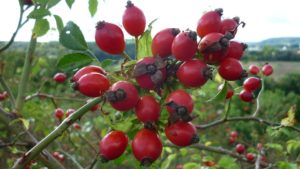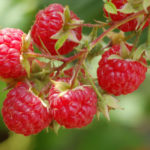Interesting facts about dogrose
 Dogrose – a plant is not only beautiful, but also useful. In fact, representing a wild rose, the dog rose into huge thick bushes, which can serve as an excellent decoration of the suburban area, and protection. Have you ever tried to get through the thorn bushes of a dogrose? If not, then do not try and do it – this idea is unlikely to end with anything good.
Dogrose – a plant is not only beautiful, but also useful. In fact, representing a wild rose, the dog rose into huge thick bushes, which can serve as an excellent decoration of the suburban area, and protection. Have you ever tried to get through the thorn bushes of a dogrose? If not, then do not try and do it – this idea is unlikely to end with anything good.
In Latin, rosehip is called Rosa and is the closest relative of these most popular flowers in the world. Moreover, in many books on botany, the dog rose is also called a rose.
In the world there are about 4 hundred kinds of dog rose and more than 50 000 varieties of this plant. On the Russian territory, up to 100 species of dog rose, many of which are found nowhere else in the world.
Some types of rose hips grow to ten meters high, others separate from the ground only 5 centimeters (for example, small dog rose-trees can be referred to as dwarf roses).
Individual specimens of rose hips grow into real trees, living for hundreds of years. The most ancient specimen known to science dog rose grows in the garden of one of the German cathedrals. The age of this wild rose is, according to various sources, from 400 to a thousand years. The trunk of the oldest dog rose at the base is 50 centimeters, and the height is 13 meters.
In the United States, another rose-tree grower grows – tree lily rose Banks. The plant was planted 15 years before the onset of the XX century and is considered the largest rose on the planet. Rose Banks stretched over an area of 740 square meters, and in the spring months its stems cover about 200 thousand flowers.
In the Crimea and near the house in Gurzuf, formerly owned by the artist Konstantin Korovin, there are also Banks roses, whose age exceeds 100 years.
A French wild rose is a shrub that can turn into a vine in a tropical forest. Its branches become long and flexible to wedge into the crown of trees and reach the sun.
The roots of the dog rose to a depth of 5 meters.
There are varieties of dog rose, completely devoid of thorns (for example, a rose hanging).
The flowers of the dog rose are known for their delicate and delicate aroma, however there are varieties of this plant with a very unpleasant smell – such, as is clear from its name, the rosehip is fetid.
In the European part of the Russian Federation flowering rosehip signals the beginning of the summer. In the early 2000’s in Kirov because of the early spring and a long warm summer, the dogrose managed to bloom repeatedly.
Rosehip wrinkled sheds its seeds directly into the sea, and they drift along the waves until they are carried ashore.
Rosehip fruits contain huge stocks of vitamins C, P and K, as well as other useful substances, which provided a safe honeysuckle place in both folk and traditional medicine. The amount of ascorbic acid in the fruits of these plants is 10 times higher than that of black currant, 50 times lemon, and 60-70 times – fir needles or pine.
Essential oils, vitamin C and other compounds, which favorably influence human organisms, accumulate in the petals of the dog rose. For example, the essential oils of this plant relieve inflammation and are fatal to bacteria.
People began to eat rose hips even at the end of the glacial period. Acidic and tart to taste, now they are widely used for making useful infusions, kvass, pastille, marmalade, jam, candies, jelly and the like. In Chinese cooking, rose hips are often used. Young branches and shoots of some species of these plants in the Caucasus were used instead of vegetables. Fruits are often added to wine and liquor to give them a special taste.



























